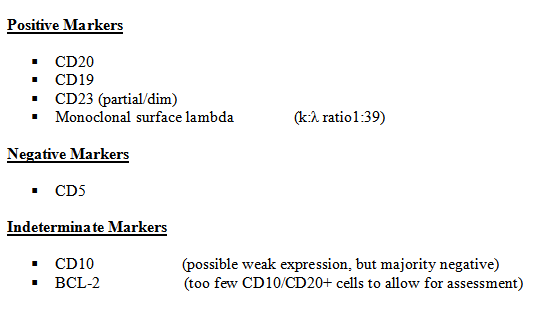
![]() Contributed by Marian Rollins-Raval, MD MPH and Raymond E. Felgar, MD PhD
Contributed by Marian Rollins-Raval, MD MPH and Raymond E. Felgar, MD PhD
CLINICAL HISTORY
The patient is a 76 year-old female who is status post partial nephrectomy for renal cell carcinoma, chromophobe subtype, four years prior to presentation. She has had no subsequent recurrence, but now presents with a mass in the anterior medial aspect of her left thigh that had been progressively enlarging over the past nine months. A few weeks before her presentation, the lesion began to grow more rapidly and became painful.
An initial ultrasound of the lesion demonstrated a lobulated, hypoechoic mass involving the superficial soft tissues of the anteromedial aspect of the left proximal thigh, with an adjacent multi-septated cystic component, concerning for a neoplastic process. MRI examination a few days later (Figure 1) also showed a 7.2 cm lobulated mass lesion with solid and cystic components. This mass appeared to be confined to the subcutaneous fat, and was not thought to invade the attaching fascia of the sartorius muscle. The radiologic differential included a neurofibroma with cystic degenerative change, a fibrous lesion with cystic component, or other neoplastic lesion of the subcutaneous fat. The mass, however, did not have an MRI signal compatible with fat and was not visible on T1 weighted images. It was T2 positive, but relatively uniform and enhanced with gadolinium.
The patient was then referred to an orthopedic oncologist for further evaluation who felt from the imaging and clinical course that this was most likely a soft tissue carcinoma. An excisional biopsy was performed.
PATHOLOGY
The surgeon requested an intra-operative consultation of the mass. Gross examination of the mass demonstrated an 8 cm homogenous, rubbery mass, with a "fish flesh" appearance that prompted the preparation of both touch imprints (figure 2) and frozen section examination (figure 3). In addition, there was an oriented fragment of skin that did not appear to be grossly involved by the mass lesion.
Representative portions of the mass were submitted for flow cytometric, histologic and cytogenetic analyses.
Results of these examinations are summarized below:
Flow Cytometry

Histology
Histologic sections demonstrated a nodular proliferation (Figure 4) of small centrocyte-like lymphocytes admixed with occasional large transformed cells (Figure 5) infiltrating soft tissue and with an appearance that suggested lymphoid follicle structures. A small portion of skin was also present as well as a portion of fibroadipose tissue with large nerve trunks and hyalinized vessels.
Immunohistochemical studies were performed in order to further characterize the cells. These findings are illustrated here, which demonstrate positive staining for the B-cell marker CD20 (Figure 6), infiltrating CD3+ T-cells in a pattern that outlines or accents follicular nodules (Figure 7), negative or weak staining for CD10 (Figure 8), positive staining for the follicular center cell marker bcl-6 (Figure 9), staining for CD21 that demonstrates proliferation of follicular dendritic cells with true follicle formation (Figure 10), lack of staining for bcl-2 within follicular nodules (Figure 11), and a ki-67 staining index consistent with a low-grade lymphoid tumor (Figure 12). In addition, a Cyclin D1 immunohistochemical stain was negative.
Fluorescence in-situ hybridization (FISH)
FISH studies using break-apart probes were negative for rearrangements of the BCL6, IGH (immunoglobulin heavy chain locus), and BCL2 genes. Figure 13 demonstrates the BCL2 study, showing no evidence of a split signal (i.e. no evidence of bcl-2 gene rearrangement).
Classical cytogenetic analysis
Eight of twenty analyzed, metaphase cells (Giemsa banding) demonstrated a deletion involving the long arm of chromosome 10, with a specific karyotype as follows: 46,XX,del(10)(q22q26.1) (Figure 14).